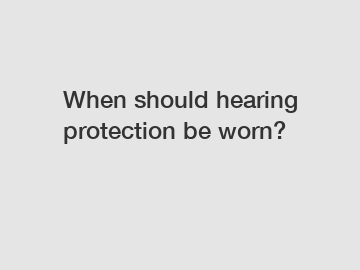When should hearing protection be worn?
When Should Hearing Protection be Worn?
In today's modern world, our senses are constantly bombarded with various forms of noise. From bustling city streets to construction sites, loud music concerts to lawnmowers in the neighborhood, noise pollution has become an unavoidable part of daily life. While we often overlook the potential harm caused by continuous exposure to loud sounds, it is essential to prioritize our hearing health. The use of hearing protection should not be taken lightly, and understanding when it should be worn is crucial to ensure we safeguard our auditory well-being.
The Occupational Safety and Health Administration (OSHA) in the United States sets guidelines regarding hearing protection in the workplace. It is mandatory for employees to wear hearing protection if their work environment typically exceeds an 8-hour time-weighted average (TWA) noise level of 85 decibels (dB) or a peak sound level of 140 dB. Industries such as construction, manufacturing, and entertainment are known for generating excessive noise levels, which can lead to workplace-induced hearing loss. Therefore, it is imperative for workers in these industries, as well as employers, to prioritize hearing protection.

Construction workers are exposed to various sources of noise, including heavy machinery, jackhammers, and power tools, which can generate noise levels exceeding 100 dB. Prolonged exposure to this level of noise can lead to permanent hearing damage. Therefore, construction workers must always wear personal protective equipment, including hearing protection, to safeguard against the detrimental effects of noise exposure.
Similarly, manufacturing plants are often filled with machinery and equipment producing high levels of noise. Workers operating in these environments must be provided with adequate hearing protection to ensure their well-being. Continuous exposure to excessive noise levels in such settings can cause hearing loss, tinnitus (ringing in the ears), and other auditory problems. Employers should prioritize employee welfare and invest in high-quality hearing protection devices to preserve the hearing abilities of their workforce.
The entertainment industry, including concert venues and nightclubs, can also pose a threat to hearing health due to the amplified sound levels. Concerts often reach noise levels exceeding 100 dB, which can lead to immediate and permanent hearing loss if not properly protected against. Musicians, sound engineers, and audience members attending such events should all use hearing protection to minimize the risk of auditory damage. Furthermore, regulations must be imposed to ensure the venues themselves are designed to minimize noise exposure and provide hearing protection options for attendees.
While workplace-related noise exposure is clearly a significant concern, it is crucial to recognize that excessive noise can also be found in various non-work settings. Activities such as hunting, motor racing, shooting ranges, and personal music listening through headphones can lead to dangerous sound levels that can cause lasting damage to our hearing abilities. For instance, firearms can produce noise levels of 140 dB or more, which is far above the recommended safe exposure level. Hunters and shooters must use appropriate hearing protection, such as earmuffs or earplugs, to guard against the dangerous auditory effects of their sports.
It is important to note that even daily household activities, such as mowing the lawn, operating power tools, or household renovations, can contribute to hearing damage. Exposure to noises above 85 dB for an extended period can prove harmful. Therefore, using hearing protection during such tasks is encouraged to mitigate the risk to our hearing.
When it comes to children, their hearing health should be given utmost importance from an early age. With the increasing use of personal electronic devices, children are particularly susceptible to damage caused by excessive and prolonged exposure to loud music or video game sounds. Parents need to educate their children about the importance of volume control and the use of headphones with noise-limiting features to protect their hearing.
In conclusion, hearing protection should be worn in any environment where noise levels exceed 85 dB or reach peak levels of 140 dB. Industries such as construction, manufacturing, and entertainment must comply with workplace safety standards and prioritize the well-being of their employees by providing high-quality hearing protection. Additionally, individuals involved in activities such as hunting, motor racing, or personal music listening should also take proactive measures to protect their hearing. It is essential for individuals, employers, and parents to raise awareness about the importance of hearing protection and ensure that this crucial aspect of our overall health is given the attention and care it deserves.
If you want to learn more, please visit our website Radio Safety Hearing Protector, Behind Head Earmuffs, Types of Ear Protection.
244
0
0

Comments
All Comments (0)